Have you tried Japchae, or Korean Stir-Fried Noodles? Chewy sweet potato glass noodles (dangmyeon) are juxtaposed with colorful stir-fried vegetables and meat and finished in a sweet and savory sauce. This recipe will show you how easy it is to cook up this beloved Korean noodle dish at home! {Vegetarian adaptable}
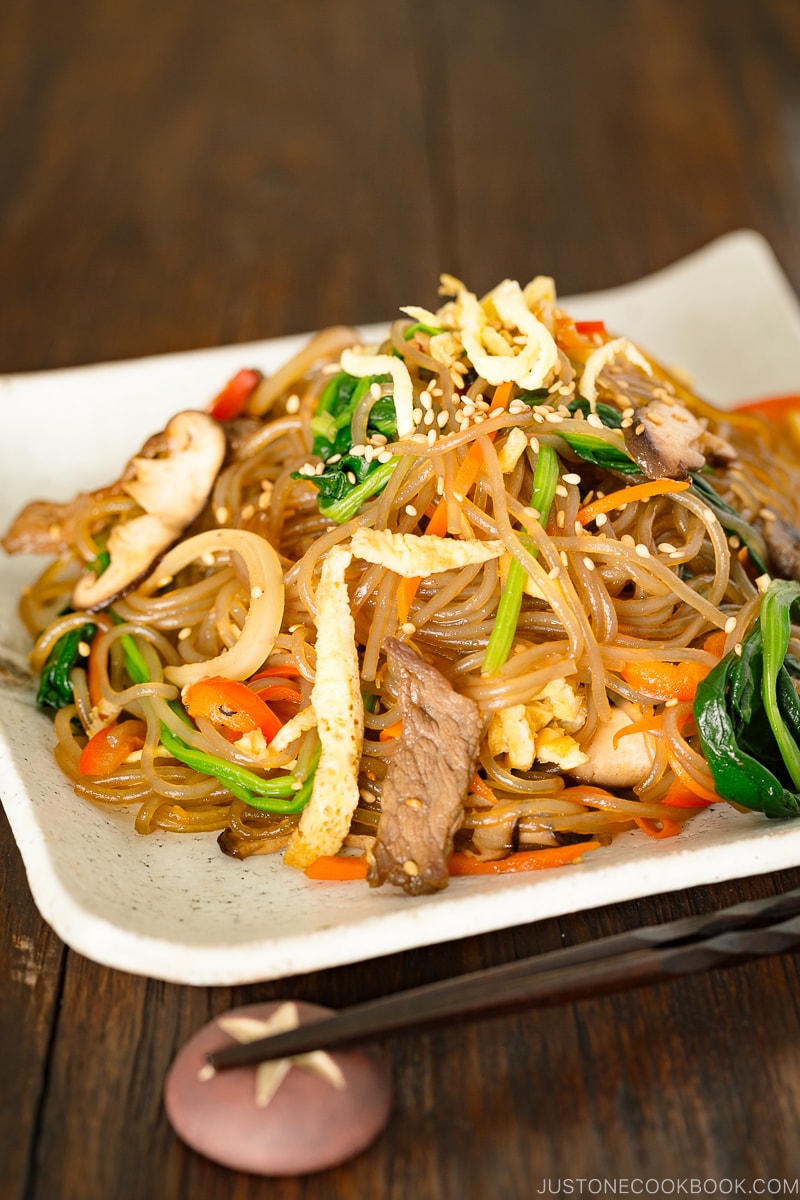
If you’re a Korean food lover, japchae needs no introduction. With chewy glass noodles, thin silvers of colorful vegetables, julienned omelet, mushrooms, and meat all on one plate, this famous Korean noodle dish might just be the perfect food.
This japchae recipe is the result of my YouTube collaboration with my good friend Seonkyoung Longest, who is a Korean-born celebrity chef. We’ll show you all the tips and tricks on how to make the best japchae at home.
Table of Contents
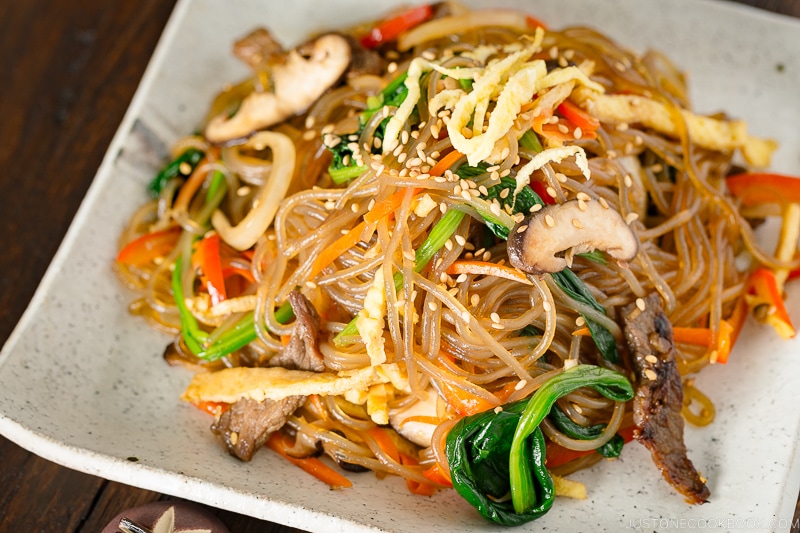
What is Japchae?
Japchae (잡채 – or chapchae) is a classic Korean stir-fried noodle dish seasoned with a sweet and savory sauce. The name japchae describes a mix of finely cut ingredients—vegetables, egg, mushroom, and meat—that are included in the noodles.
According to Seonkyoung, Korean cuisine shares the same philosophy as Japanese cuisine where the balancing of colors and seasonality are taken into consideration. The juxtaposition of flavors and textures and the vibrant colors are all part of the appeal of a recipe like japchae.
As one of Korea’s most-loved dishes, not only can you find japchae being served at small parties, fancy banquets, and special occasions like New Year’s day, but it is also a staple dish enjoyed any day of the week.
In Korea, people enjoy japchae hot, warm, or even at room temperature, because it is delicious regardless of how you serve it.
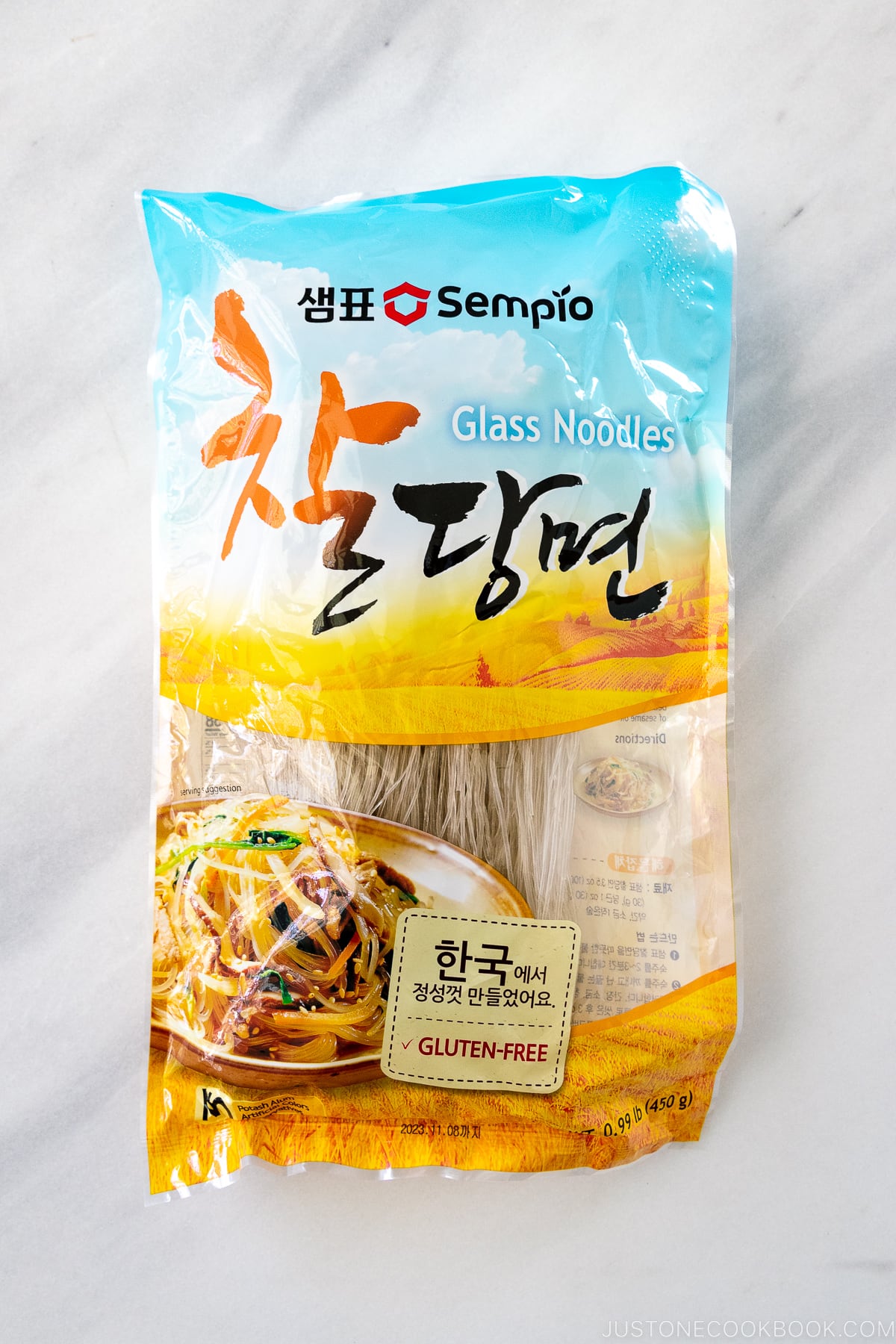
What Are Korean Sweet Potato Glass Noodles (Dangmyeon)?
Korean sweet potato glass noodles called dangmyeon (당면) are made from the starch of sweet potatoes. They do not contain wheat so they are gluten-free.
The noodles are stiff and grayish looking and often sold dried in a big bag. Once cooked, they become translucent and tender. They also come in long strands, so you’ll need to cut them in half or thirds after cooking.
You can buy Korean sweet potato glass noodles in Korean or most Asian grocery stores. Amazon and other online Asian grocers also carry them too.
Learn more about dangmyeon in my pantry post.
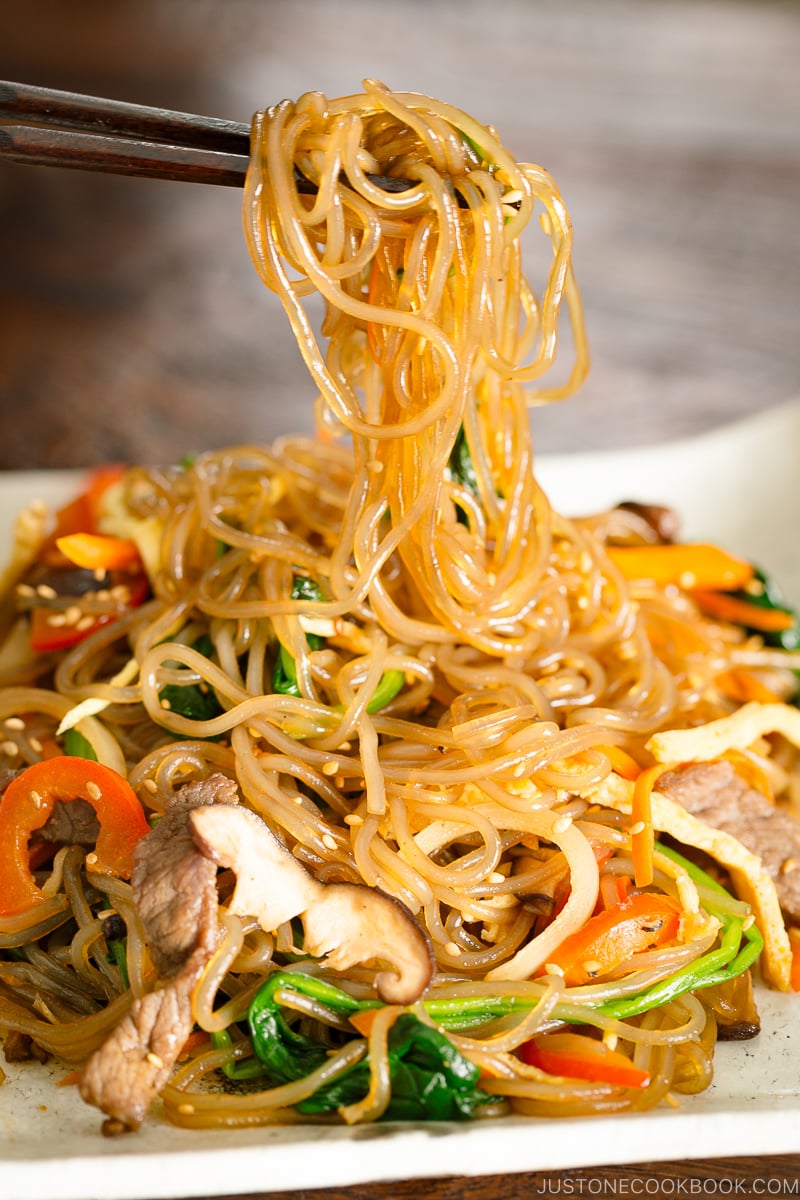
How to Make Japchae
You’ll need to do some prep work to get all the ingredients ready, but apart from that, japchae is a relatively easy dish to put together. The noodles store well in the refrigerator for a day or two and reheat easily, so you can definitely make it in advance.
Ingredients You’ll Need
- Korean sweet potato glass noodles (dangmyeon): These springy glass noodles are an integral component of japchae. Please do not substitute it with other types of glass noodles. It will change the character of the dish. The good news is you can easily find sweet potato noodles in Korean or Asian grocery stores or online.
- Vegetables: We used onion, carrots, bell peppers, and spinach in the recipe.
- Shiitake mushrooms: If you cannot find shiitake mushrooms, sub with other meaty types of mushrooms.
- Eggs: You make a thin omelet and cut it into thin strips. You can leave it out for a vegan japchae.
- Protein: We used thinly sliced beef, but you can leave it out or swap it with seafood, tofu, or use more shiitake mushrooms.
- Roasted sesame oil: It adds an unmistakably wonderful and nutty aroma to the dish. Use generously.
- Japchae sauce: Korean soy sauce*, sugar, sesame oil, sesame seeds, garlic, and black pepper.
*Korean soy sauce is best, but you can sub it with Japanese soy sauce.
Overview: Cooking Steps
- Cut all the ingredients into julienne strips. It’s important to thinly slice all the ingredients into a uniform shape so they mix well with the long noodles. That way when you eat, the veggies, eggs, and meat will cling to the noodles and have more balanced flavors.
- Stir fry, blanch, and cook each ingredient separately. Each ingredient has a different texture and it requires a different cooking time, so we need to cook them separately. Stir-frying everything all at once in the frying pan will only result in uneven textures as some vegetables will wilt before the others are cooked. Cooking separately also helps keep the colors of each ingredient nice and bright!
- Mix all together! After everything is prepared and cooked, place the ingredients in a large platter or bowl, then pour the sauce over the noodles first and let them absorb the flavors. Once the noodles are well coated, get ready to mix! We’ll do the traditional Korean way by putting on plastic gloves and tossing the noodles with everything else together.
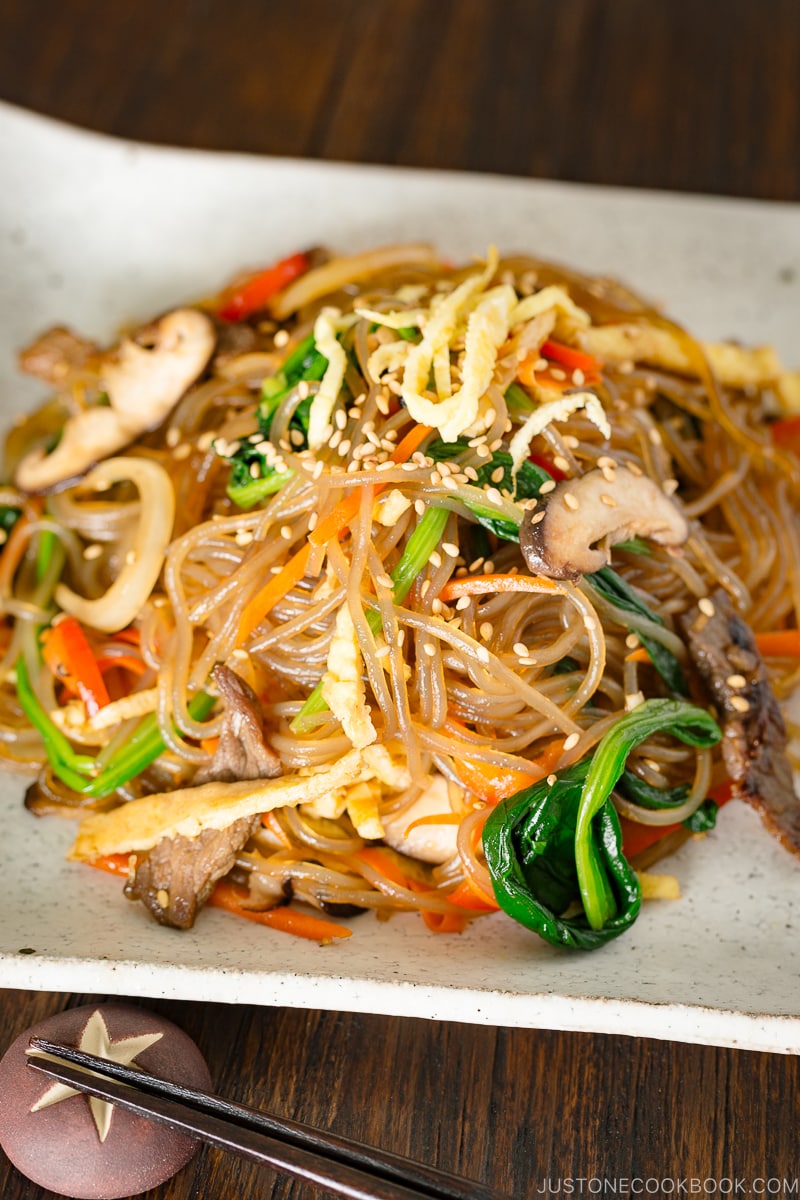
What Dishes to Serve with Japchae
I love that you can enjoy japchae in any way you like. It certainly makes a fulfilling standalone meal itself. For a party, you can serve it on a large platter directly as the main dish on the table, or as a smaller side (banchan) along with other dishes.
Here are some of our favorite recipes that go well with japchae:
- Quick Korean Fresh Kimchi
- Korean Pancake
- Gluten-Free Korean Veggie Pancake
- Kimchi Jjigae (Kimchi Stew)
- Kimbap (Korean Seaweed Roll)
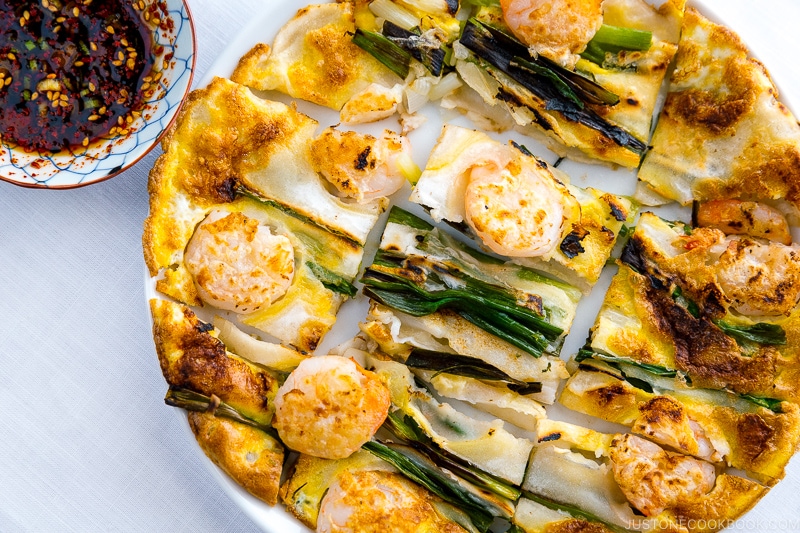
More Korean Recipes
If you enjoy Korean cuisine, please visit Seonkyoung at her website and YouTube channel. She’s a gem and I know you’ll love her!
Last but not least, I wanted to thank Seonkyoung for collaborating with me to make this amazing recipe video for JOC readers. This has been a fun and enriching experience, and we both hope that you enjoy watching our video and making japchae with us.
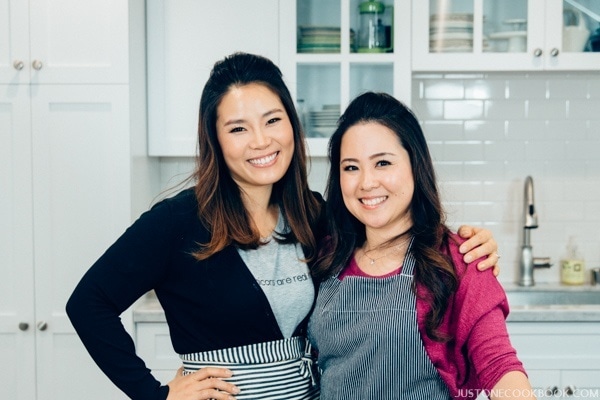
Wish to learn more about Japanese cooking? Sign up for our free newsletter to receive cooking tips & recipe updates! And stay in touch with me on Facebook, Pinterest, YouTube, and Instagram.
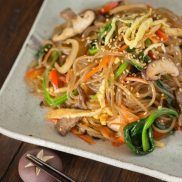
Japchae (Korean Stir-Fried Noodles)
Video
Ingredients
For the Beef
- 1 Tbsp Korean soy sauce (or use Japanese soy sauce)
- 1 Tbsp sugar
- ½ Tbsp toasted sesame oil (for marinating the beef)
- ½ Tbsp mirin
- 1 clove garlic (chopped)
- ½ lb beef (sirloin or chuck; skip for vegetarian)
- 1 Tbsp toasted sesame oil (for cooking the beef, as needed)
For the Eggs and Vegetables
- 2 large eggs (50 g each w/o shell) (lightly beaten)
- toasted sesame oil (for cooking the eggs and vegetables, as needed)
- ½ onion (4 oz, 114 g)
- Diamond Crystal kosher salt (to season the vegetables, as needed)
- 5 shiitake mushrooms
- ½ carrot (1.5 oz, 43 g)
- ¼ red bell pepper
- 12 oz fresh spinach (about 1 bunch)
For the Noodles
- 14 oz Korean sweet potato glass noodles (dangmyeon)
- toasted sesame oil (for coating the cooked noodles, as needed)
For the Sauce
- ⅓ cup Korean soy sauce (or use Japanese soy sauce)
- ⅓ cup sugar (or honey)
- 2 Tbsp toasted sesame oil
- 1 Tbsp toasted white sesame seeds
- 1 clove garlic (chopped)
- freshly ground black pepper
For Assembling the Japchae
- toasted white sesame seeds (as needed)
Instructions
- Gather all the ingredients.
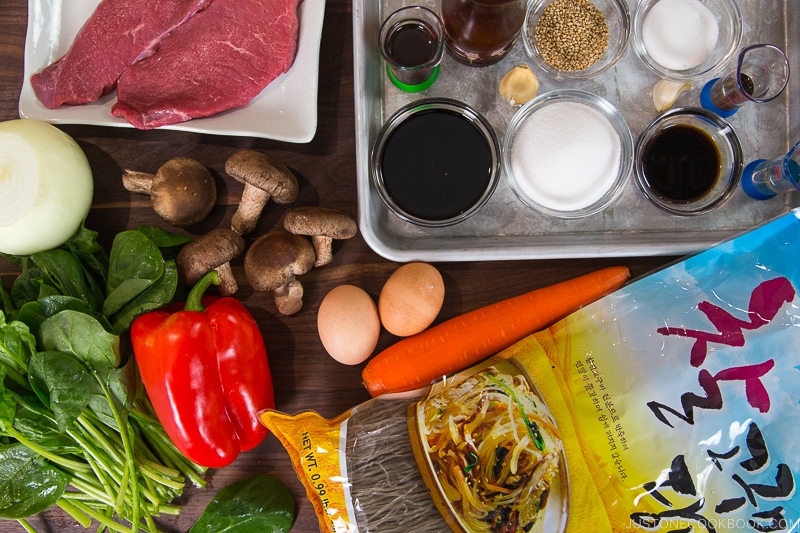
To Marinate the Beef
- In a medium bowl, combine the seasonings for the beef: 1 Tbsp Korean soy sauce, 1 Tbsp sugar, ½ Tbsp toasted sesame oil, ½ Tbsp mirin, and 1 clove garlic (chopped). Whisk it all together. Cut ½ lb beef into thin strips 3 inches (7.6 cm) long. Add the beef to the bowl with the sauce and toss to coat evenly. Set aside to marinate for at least 10 minutes.
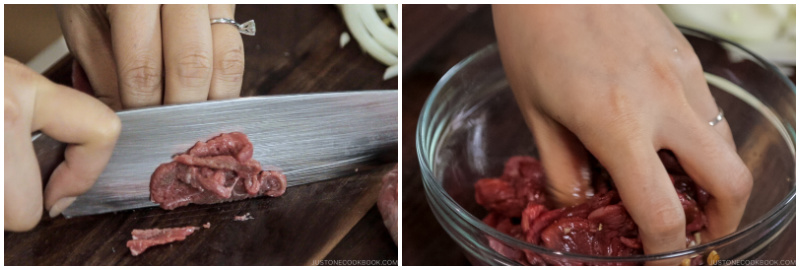
To Cut the Vegetables
- Thinly slice ½ onion and 5 shiitake mushrooms.
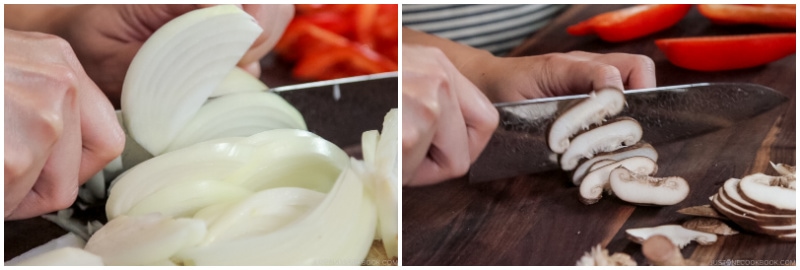
- Cut ½ carrot and ¼ red bell pepper into thin julienne strips.
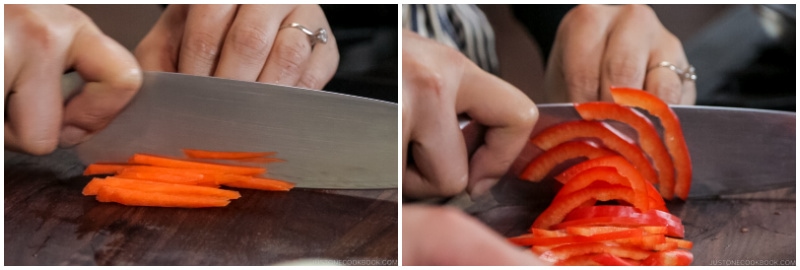
To Cook the Toppings
- Now, make the omelette. (If doubling the recipe, make 2 omelettes with 2 eggs each.) Heat a large frying pan on medium heat. When the pan is hot, add 1–2 tsp toasted sesame oil and distribute it evenly in the pan (use less for a nonstick pan, more for a regular pan). Next, beat and add 2 large eggs to the pan and swirl them around to cover the pan‘s surface in a thin layer. Cook until it’s just set, about 2 minutes. Then flip the egg over and cook for another 2 minutes. Transfer the omelette to a plate to let cool.
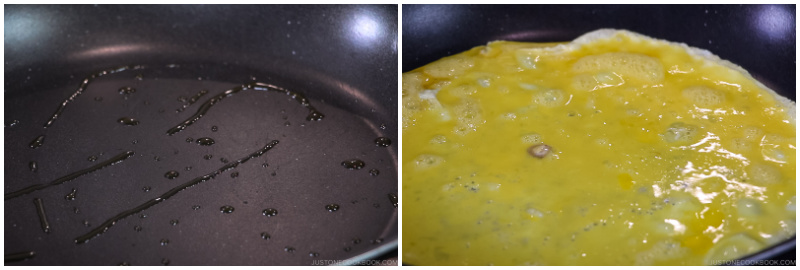
- Next, we‘ll cook the vegetables. Make sure to cook each different vegetable separately, starting with the light-colored ones and ending with the dark-colored ones, so that they will retain their beautiful colors. In the same pan that you just used (without washing), heat 1–3 tsp toasted sesame oil over medium heat. Add the sliced onions and a pinch of salt and sauté until tender. Remove the onions from the pan to a platter large enough to eventually hold all the cooked ingredients.
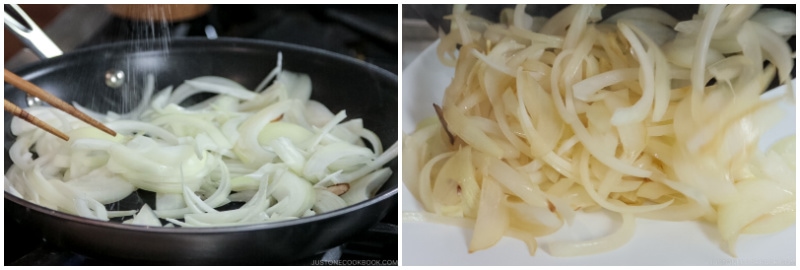
- In the same pan, repeat this process with the shiitake mushrooms next, followed by the carrot strips, and ending with the bell pepper strips. As you finish cooking each ingredient, place in a separate pile on the platter.
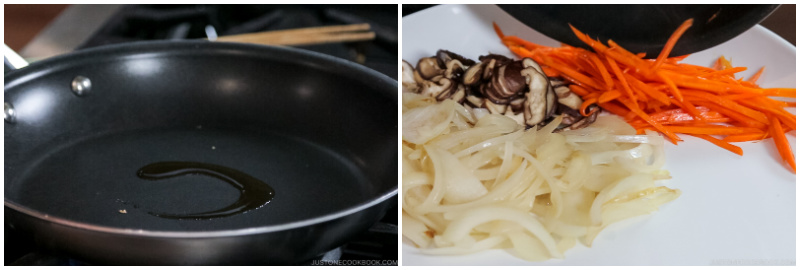
- Now, cook the beef. Using the same pan over medium heat, heat 1–3 tsp toasted sesame oil and add the marinated beef and sauté until cooked through and all the moisture has evaporated. Transfer from the pan to the large platter with the cooked vegetables.
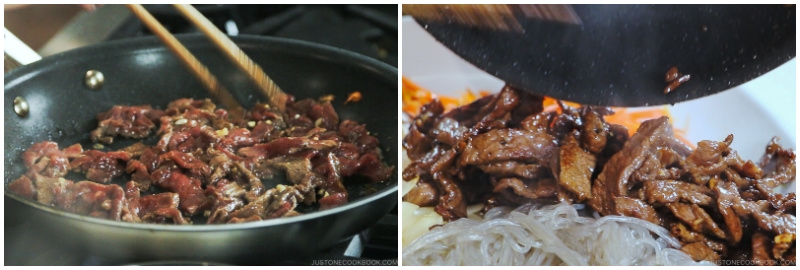
- When the omelette is cooled, roll it up and cut it into thin ribbons. Set aside on a separate plate.
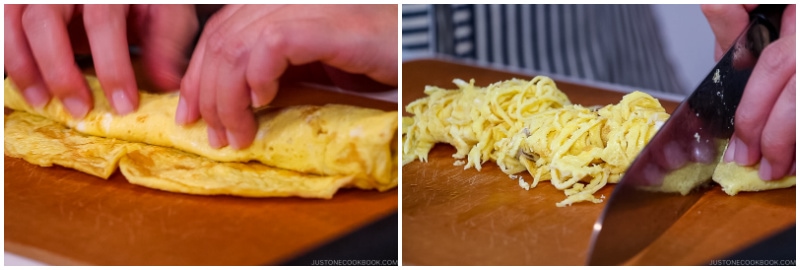
- Bring a large pot of water to a boil. In the meantime, prepare a large bowl of iced water. Once the water is boiling, add 1 tsp Diamond Crystal kosher salt and 12 oz fresh spinach. Cook for about 10–15 seconds (American spinach is more tender than Japanese spinach). Use tongs or chopsticks to transfer the spinach from the pot to the iced water to stop the cooking. (You‘ll cook the noodles next in this boiling water, so do not discard it.) Gather the spinach and squeeze out as much water as you can. Add the spinach to the platter with the other cooked ingredients.
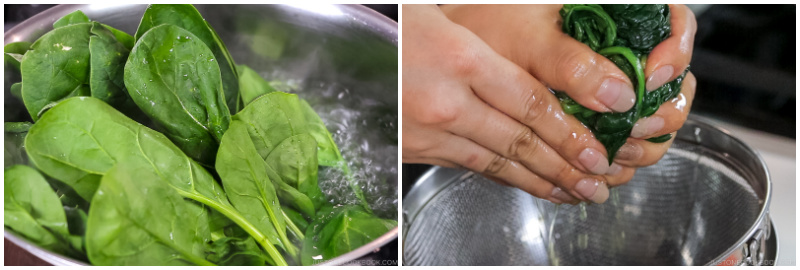
To Cook the Noodles
- Add 14 oz Korean sweet potato glass noodles (dangmyeon) to the same boiling water that you used to blanch the spinach. Boil the noodles according to the package directions, about 6 to 10 minutes. Drain well, transfer to a bowl, and toss with some toasted sesame oil to coat so the noodles don‘t stick to each other. Cut the long noodles with kitchen shears so it‘s easier to eat and they‘ll mix easily with the sauce and toppings. Then, add the noodles to the platter in a pile next to the rest of the cooked ingredients.
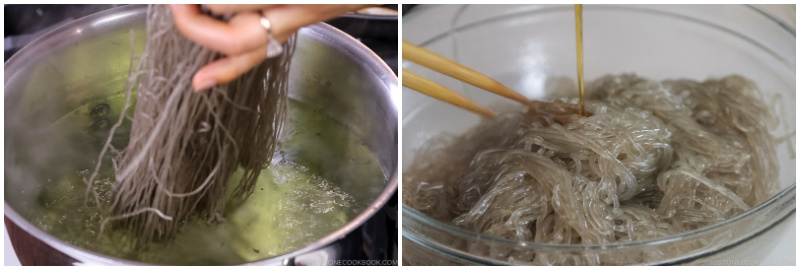
To Assemble the Japchae
- In a small bowl, combine all the ingredients for the sauce: ⅓ cup Korean soy sauce, ⅓ cup sugar, 2 Tbsp toasted sesame oil, 1 Tbsp toasted white sesame seeds, 1 clove garlic (chopped), and freshly ground black pepper. Whisk well. Pour the sauce only on top of the noodles.
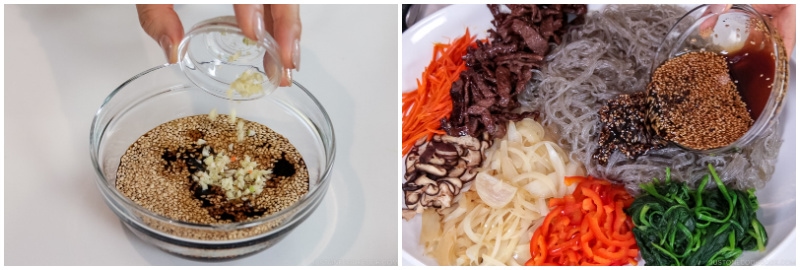
- Combine the sauce and noodles first so that the noodles can absorb the sauce (I used my gloved hand). Once the noodles are well coated, add in the stir-fried vegetables and beef and mix everything together.
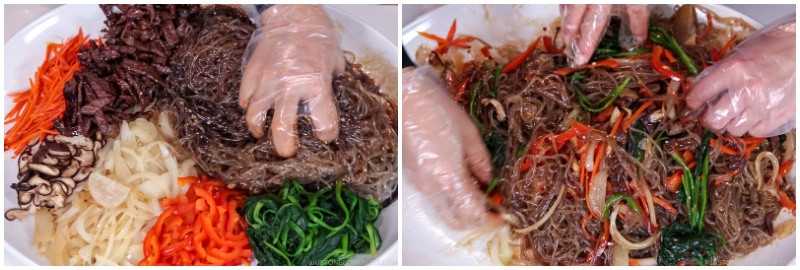
- Finally, add half of the omelette ribbons and some sesame seeds and toss together. Transfer to a serving platter and garnish the Japchae with the rest of the omelette ribbons and more toasted white sesame seeds, as desired. Serve warm or at room temperature. Enjoy!
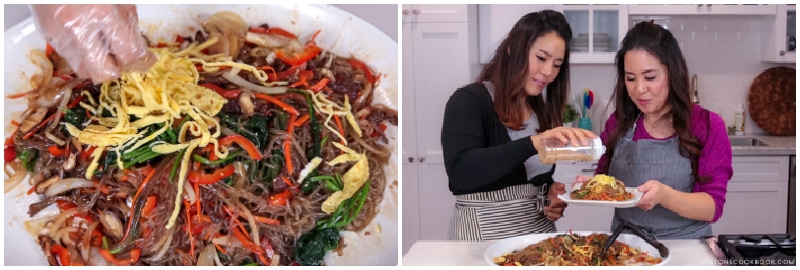
To Store
- You can keep the leftovers in an airtight container for up to 2 days. When you are ready to serve, reheat it in a frying pan with 1–3 tsp of oil and 1–2 Tbsp of water until the noodles become translucent again.
Notes
Nutrition
Editor’s Note: This post was originally published on February 5, 2016. The post has been updated with more information in August 2022.
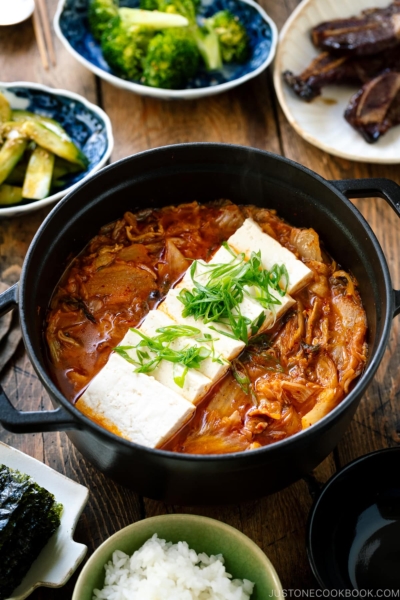
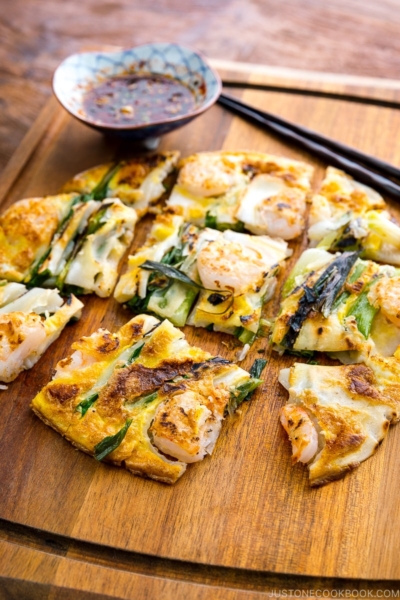
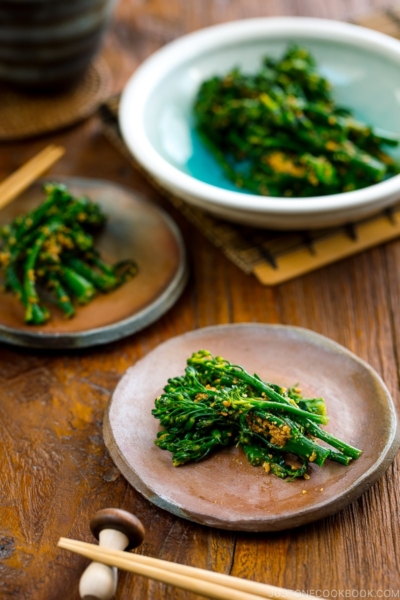
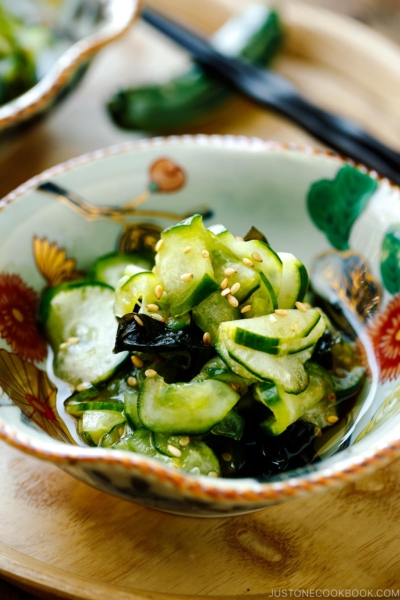




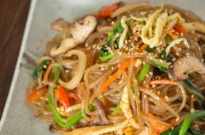
Hi Nami,
Thank you for sharing this wonder recipe. As I cannot take beef, I am replacing it with either pork or chicken. Do I use the same seasoning for them? Or they should be seasoned with different ingredients? Appreciate your advise. Tks!
Hi Rebecca! Same seasonings will do! Enjoy!!
Hi Nami, Thks for the advice.!
Can you use Japanese “Ito konnyaku” instead of the Korean sweet potato noodles? Is it the same?
It’s not the same, BUT if it’s for diet purpose and you know that it’ll be very different texture, I think it might work for you. It’s just not the same texture and flavors. 🙂
Thank you for the recipe! It’s golden. The sauce for the noodles is SO GOOD. I have to make this once a week for my husband (and his friends)!
Hi Iris! I’m so happy you and your husband (as well as his friends!) enjoyed this recipe! Thank you for your kind feedback!
I made this for a friend, who is a vegetarian, so I cooked the beef in a separate pan for myself and fried up some tofu for her. We both loooooved this! I wish I could attach the photo I took of all the prepared ingredients before we mixed them up because it looked absolutely beautiful! The only ingredient I couldn’t find were the sweet potato noodles. I used bean thread noodles instead and I can only imagine how much more perfect it would taste with the correct noodles! I tried another version of this recipe out of a korean cookbook I found at the library, but I think I liked this version better!
Hi Carolyn! Yay!!! I’m so happy to hear you two enjoyed this recipe! JOC readers share their pictures on my Facebook page or Instagram with hashtag #justonecookbook (so I can see what everyone is making!). I really love this recipe too! Hope you can find the korean sweet potato noodles next time! You can purchase on amazon too.
https://www.justonecookbook.com/pantry_items/korean-sweet-potato-noodles/
I always like Japanese,Thai and Vietnamese dishes, I have several books and my last one was Pailin.. .They all taste wonderful being spicy, luv, luv them!????????????!
Hi Lorna! Happy to hear you like Asian foods! 🙂
I used your recipe to make japchae for the first time this past weekend and it was really delicious! The video was very helpful since there are quite a few steps required for this particular recipe (I actually watched it a few times before heading in to the kitchen). The seasonings were perfect and the end result tasted much like the japchae my Korean mother-in-law makes. Thank you so much for the great recipe and video!
Hi Traci! I’m so happy to hear that you liked it! Thank you for trying this recipe. I love it too! Thank you for your kind feedback. 🙂
This took really long and used so many dishes. Not an after-work meal. I’m exhausted.
Taste was a little too sweet.
I’m disappointed Nami . I tried many of your recipes from both cheesecakes to kabocha soup to chicken meatballs and they’re all so easy and perfectly delicious.
Hi Sandra! I know, it’s probably not a weeknight recipe as it requires you to cooking different ingredients separately etc. I cooked this with Seonkyoung so I guess it helped shortening cooking time.
Sorry that you felt it’s too sweet. You can reduce the amount of sugar or switch to honey next time (it won’t affect much to the final result except for less sweet). I’ve tried Japchae many times before, but I really love this recipe written by Seonkyoung. Maybe it’s on sweet side, but my family enjoy this dish so much. This food is often eaten at room temperature. When the food is served at room temp, it’s often seasoned extra (both salty and sweet) so that it tastes better (good example is Japanese bento served that always served at room temp).
Hope this helps! 🙂 Thank you sooo much for trying my recipes! I’m happy to hear you enjoy them. xo
Hi! Nami. Great video!!!! You did a very good job and Seonkyoung is a natural and you too will be soon, Keep up the great work and I’m enjoy wearing my =Nozomi necklace. Please note my new email address. I do not want to miss 1 recipe. Go Nami!!!!!
Hi Chiyo! Thanks so much! I’m happy to hear you liked this collaboration! And I’m so happy you like your nozomi necklace. Love their collection very much. I think you’re subscribed, if you didn’t receive a newsletter about how to season your donabe (earhtenware pot), let me know. 🙂
Hi Nami,
Thank you to you and Seonkyoung for the japchae recipe! The japchae was delicious and very healthy. The instructions for the noodles called for rinsing the noodles in cold water but I followed the recipe and added some sesame oil and the noodles did not stick together. I also like the fact that the noodles are mixed with the vegetables and meat on a plate thus avoiding the noodles sticking to a hot pan.
Thanks,
Darlene
Hi Darlene! So happy to hear you tried this recipe! Thanks so much for your kind feedback! I also love the idea of mixing on a plate too! Thank you Darlene!
Thanks to both of you for sharing this recipe! I always pick up a pack of this dish ready-made on HMart shopping trips, so it’s nice to know how easy it is to make the same dish at home from scratch. Also, I love that the two of your are rocking the same hairstyle in the video. 🙂
Hi Kimmi! Thank you for watching our videos! You’re so lucky to live near HMart. My Korean grocery store is 45 mins away! You’ll love making this dish at home! He hee did you notice about our hair? 😉
Thumbs up to both of you. A joy to watch you in the kitchen. Nami, never again worry about being seen on camera…you are a delight. I make Japchae frequently but next time I’ll make this version. I like the addition of eggs and the way you mix everything at end on plate rather than stir frying in pan. THANK YOU!!!
Hi Lyn! Thank you so much for your sweet words. Hope practicing will help overcome my fear. 🙂 Hope you enjoy this recipe. I REALLY love this recipe and mixing at the end on a plate is a brilliant idea!
I’m looking forward to get more korean recipes and try them out! What a brilliant idea, Asian at home!!!
Today, we’re gonna make japchae at home, here in Sweden! Since I’m celiac I enjoy every recipe made glutenfree, japchae is perfect! Now, I couldn’t find korean sweet potato noodles in the store, but I do have soba noodles that is made with half buckwheat half sweet potato, or japanese harusame, without sweet potato though. Which sort of them two would substitute better?
And then, fresh spinach I can find here in Sweden is called “baby spinach” and very tiny, thin and I guess the leaves become very mushy efter soaking… I could use frozen spinach (that is more like chopped spinach you use) or substitute with…. bok choy? swiss chard? Maybe? Or take rhe baby leaves and do the soaking shorter?
Hi Genus! You’ll love Seonkyoung’s blog and youtube channel! Hope you’ll enjoy cooking her recipes!
Oh yes, Japchae is perfect a great noodle dish for you! Hope you can find sweet potato noodles there. Harusame is made of mung bean, and vermicelli is made of rice or mung bean, so it’s a little different. I think harusame is good substitute IF you can’t find sweet potato noodles. The texture and taste is a bit different. In the US we have baby spinach too. And they are so tender that you probably need to just soak for 2-3 second and take it out! It’s better than using frozen spinach or bok choy. The texture of noodles are so soft, and bok choy or swiss chard are pretty hard, so they don’t cling too well with noodles. Hope this makes sense. 🙂 Enjoy!
For the record, vermecilli noodles do not substitute for the sweet potato noodles. Look for the required noodles. And I’m guessing the beef should be cooked first, to let the flavor infuse the veggies….?
Hi Lisa! Yes vermicelli noodles are from rice or mung bean and these Japchae noodles are made from sweet potato, so it’s different. Thank you very much for pointing out!
We cooked the beef after veggies. Gasp! I just scrolled up to see the recipe to make sure and I realized the beef cooking step is not included! I accidentally deleted the beef cooking step when I was consolidating the veggie cooking steps!!! It should be step 7, and I’ll add it now! Thanks so much for letting me know! Oh no~~~~!
I think this is my first time leaving a comment on your blog Nami!! What a shame!!! >.<;; I always just sneak in and see what you up to, what's new here and etc. lol
Thank you so much explain all the cooking steps and why it has to happen, it is so well explained!!
I almost cried(actually teared up) reading Behind the Scene part, I miss you so much!!!
I'm off to adding the Japchae video and link of this post on my blog!! 😀
Love you!!! <3 <3 <3
Hi Seonkyoung! Bloggers/YouTubers are so busy, we have to create our content and answer to questions…and I barely have time to leave a comment on blogs or videos anymore so please don’t feel bad. 🙂
I haven’t had a chance to say thanks for all of your snapchat shoutout. Your kindness melt my heart. xo
Thanks so much for adding this video to your Japchae post on your blog! I appreciate it. I’ll do the same for my Teba Shio post (I didn’t think about it, great idea!). xoxo
It was a pleasure to watch you ladies make this wonderful dish! I would never have guessed you had been uncomfortable in front of the camera. You really seem like a natural. I read your newsletters and watch your videos all the time. Can’t wait to try out this recipe! I am learning so much. Keep up the great work!
Hi Sandra! Thank you so much for watching our videos! Yeah… very uncomfortable. It’s fear that is in my head that I can’t get rid of… xD You will LOVE this recipe. I really do and I’ll be making this recipe from now on and every time will be a huge success! Thank you for writing, Sandra! xo